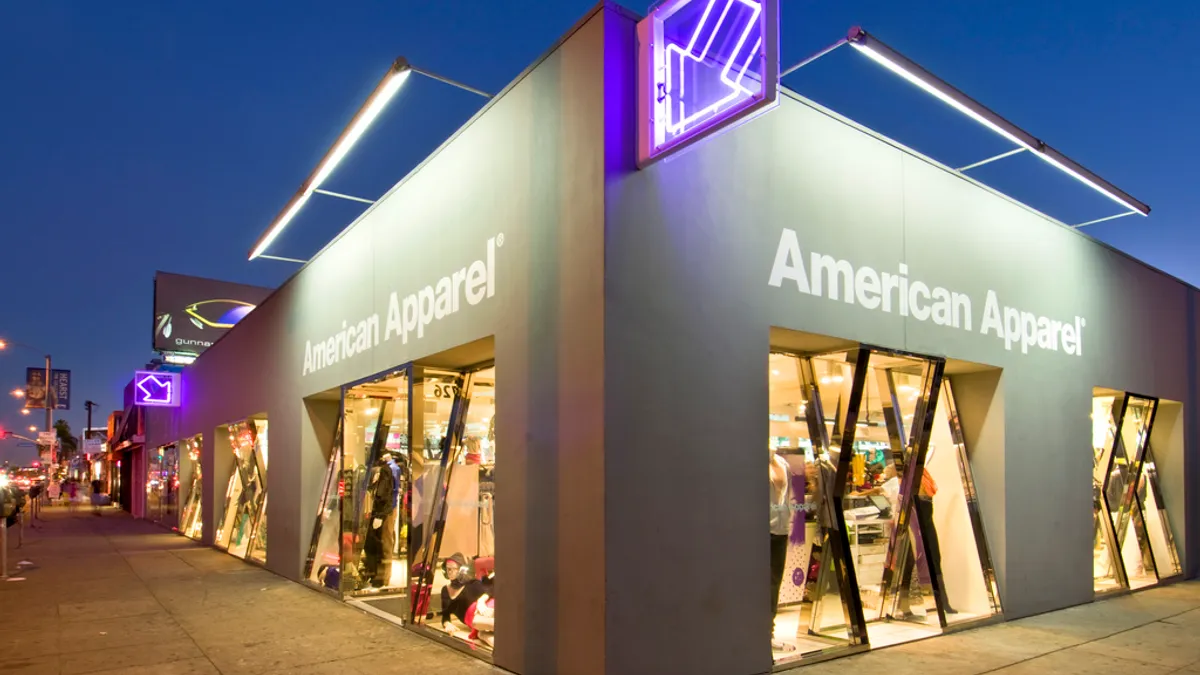Dive Brief:
-
UPDATE: About 500 American Apparel employees have been laid off, Nativo Lopez, an adviser with Hermandad Mexicana, told the Los Angeles Times on Tuesday.
-
UPDATE: According to a letter obtained by the LA Times, American Apparel CEO Paula Schneider said that the cuts were part of a "redesign of our production process" that will see the company cut down on inventory to avoid discounts. The letter also hinted that the retailer may move some of its manufacturing outside of Los Angeles, although products would still be American-made.
-
Hermandad Mexicana told Orange County Register Friday that the moves are coming as the union was seeking certification from the National Labor Relations Board as the exclusive collective bargaining entity with American Apparel, and that the layoffs are meant to “winnow out union supporters prior to the election,” according to a statement from union president Stephanie Padilha dos Santos as reported by the Register.
-
Schneider last week sent a letter to employees indicating that the retailer is consolidating manufacturing into a single floor of its largest downtown Los Angeles factory to cut costs, improve logistics and “to ensure consistency and quality,” according to news reports. American Apparel hasn’t commented on the reports from the union or Schneider’s letter.
Dive Insight:
"Made in the U.S.A.” manufacturing has been a staple of American Apparel’s identity since Dov Charney founded the company in 1989. And for years, analysts have noted that domestic manufacturing is an important differentiator for the retailer. Nearly 80% of Americans would rather buy an American-made product than an import, and more than 60% say they’d pay as much as 10% more for it, according to a Consumer Reports study released last year.
Charney also took pride that his workers were well treated and well paid, and Hermandad Mexicana staged protests in his defense as he tried to regain control of American Apparel after being let go in a dramatic showdown last summer. He continued that effort even during the company’s recent bankruptcy process earlier this year.
UPDATE: On Tuesday, Charney told the LA Times that with these moves, the company is "doing exactly what American Apparel fought against."
Since taking the reins from Charney a little over year ago, Schneider has also touted the virtues of domestic manufacturing, and says American Apparel remains committed to the approach. In fact, she now says that the retailer could also include accessories (many of which are sourced internationally) among its "Made in the U.S.A." offerings.
But an increasing amount of American Apparel merchandise has been outsourced since Schneider's arrival. That could be paving the way to turn to overseas production if costs continue to be a burden for the company, which just emerged from Chapter 11 earlier this year.
Certainly, “Made in the U.S.A.” is more expensive. But there’s another problem: More and more of American Apparel’s rivals are embracing the same philosophy.
“American Apparel is squeezed in between supercheap, foreign-made brands and higher-end U.S.-made retailers such as Imogene + Willie," Christina Cauterucci wrote in a Slate editorial last year. "American Apparel’s products are more expensive and less responsive to trends than the former, but feature lower-quality material and construction than the latter.”
Cauterucci believes the retailer should consider scaling back and making fewer styles of higher quality. “Retire some of the old prints and styles that no longer register as cool,” she said. “It should start sizing its clothes within the bounds of reality and try out contemporary silhouettes beyond the bandeau top and the slouchy sweater.”















